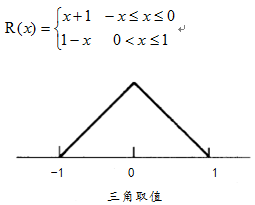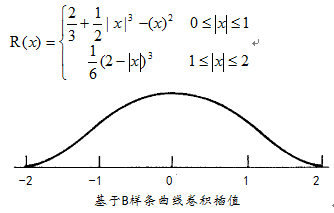三种常见的图像处理双三次插值算法
双立方插值计算涉及16像素,间(i’, j’)像中的包括
小数部分的像素坐标。dx表示X方向的小数坐标。dy表示Y方向的小数坐标。
详细
能够看下图:
依据上述图示与双立方插值的数学表达式能够看出。双立方插值本质上图像16个像素点
权重卷积之和作为新的像素值。
当中R(x)表示插值表达式,能够依据须要选择的表达式不同。常见有基于三角取值、Bell
分布表达、B样条曲线表达式。
1. 基于三角形採样数学公式为
最简单的线性分布,代码实现例如以下:
private double triangleInterpolation( double f ){ f = f / 2.0; if( f < 0.0 ) { return ( f + 1.0 ); } else { return ( 1.0 - f ); }} 2.基于Bell分布採样的数学公式例如以下: Bell分布採样数学公式基于三次卷积计算实现。代码实现例如以下:
private double bellInterpolation( double x ){ double f = ( x / 2.0 ) * 1.5; if( f > -1.5 && f < -0.5 ) { return( 0.5 * Math.pow(f + 1.5, 2.0)); } else if( f > -0.5 && f < 0.5 ) { return 3.0 / 4.0 - ( f * f ); } else if( ( f > 0.5 && f < 1.5 ) ) { return( 0.5 * Math.pow(f - 1.5, 2.0)); } return 0.0;} 3.基于B样条曲线採样的数学公式例如以下: 是一种基于多项式的四次卷积的採样计算,代码例如以下:
private double bspLineInterpolation( double f ){ if( f < 0.0 ) { f = -f; } if( f >= 0.0 && f <= 1.0 ) { return ( 2.0 / 3.0 ) + ( 0.5 ) * ( f* f * f ) - (f*f); } else if( f > 1.0 && f <= 2.0 ) { return 1.0 / 6.0 * Math.pow( ( 2.0 - f ), 3.0 ); } return 1.0;} 实现图像双立方插值的完整源码例如以下: package com.gloomyfish.zoom.study;import java.awt.image.BufferedImage;import java.awt.image.ColorModel;import com.gloomyfish.filter.study.AbstractBufferedImageOp;public class BicubicInterpolationFilter extends AbstractBufferedImageOp { public final static int TRIANGLE__INTERPOLATION = 1; public final static int BELL__INTERPOLATION = 2; public final static int BSPLINE__INTERPOLATION = 4; public final static int CATMULLROOM__INTERPOLATION = 8; public final static double B = 0.0; public final static double C = 0.5; // constant private int destH; // zoom height private int destW; // zoom width private int type; public BicubicInterpolationFilter() { this.type = BSPLINE__INTERPOLATION; } public void setType(int type) { this.type = type; } public void setDestHeight(int destH) { this.destH = destH; } public void setDestWidth(int destW) { this.destW = destW; } private double bellInterpolation( double x ) { double f = ( x / 2.0 ) * 1.5; if( f > -1.5 && f < -0.5 ) { return( 0.5 * Math.pow(f + 1.5, 2.0)); } else if( f > -0.5 && f < 0.5 ) { return 3.0 / 4.0 - ( f * f ); } else if( ( f > 0.5 && f < 1.5 ) ) { return( 0.5 * Math.pow(f - 1.5, 2.0)); } return 0.0; } private double bspLineInterpolation( double f ) { if( f < 0.0 ) { f = -f; } if( f >= 0.0 && f <= 1.0 ) { return ( 2.0 / 3.0 ) + ( 0.5 ) * ( f* f * f ) - (f*f); } else if( f > 1.0 && f <= 2.0 ) { return 1.0 / 6.0 * Math.pow( ( 2.0 - f ), 3.0 ); } return 1.0; } private double triangleInterpolation( double f ) { f = f / 2.0; if( f < 0.0 ) { return ( f + 1.0 ); } else { return ( 1.0 - f ); } } private double CatMullRomInterpolation( double f ) { if( f < 0.0 ) { f = Math.abs(f); } if( f < 1.0 ) { return ( ( 12 - 9 * B - 6 * C ) * ( f * f * f ) + ( -18 + 12 * B + 6 *C ) * ( f * f ) + ( 6 - 2 * B ) ) / 6.0; } else if( f >= 1.0 && f < 2.0 ) { return ( ( -B - 6 * C ) * ( f * f * f ) + ( 6 * B + 30 * C ) * ( f *f ) + ( - ( 12 * B ) - 48 * C ) * f + 8 * B + 24 * C)/ 6.0; } else { return 0.0; } } @Override public BufferedImage filter(BufferedImage src, BufferedImage dest) { int width = src.getWidth(); int height = src.getHeight(); if (dest == null) dest = createCompatibleDestImage(src, null); int[] inPixels = new int[width * height]; int[] outPixels = new int[destH * destW]; getRGB(src, 0, 0, width, height, inPixels); float rowRatio = ((float) height) / ((float) destH); float colRatio = ((float) width) / ((float) destW); int index = 0; for (int row = 0; row < destH; row++) { int ta = 0, tr = 0, tg = 0, tb = 0; double srcRow = ((float) row) * rowRatio; // 获取整数部分坐标 row Index double j = Math.floor(srcRow); // 获取行的小数部分坐标 double t = srcRow - j; for (int col = 0; col < destW; col++) { double srcCol = ((float) col) * colRatio; // 获取整数部分坐标 column Index double k = Math.floor(srcCol); // 获取列的小数部分坐标 double u = srcCol - k; double[] rgbData = new double[3]; double rgbCoffeData = 0.0; for(int m=-1; m<3; m++) { for(int n=-1; n<3; n++) { int[] rgb = getPixel(j+m, k+n, width, height, inPixels); double f1 = 0.0d; double f2 = 0.0d; if(type == TRIANGLE__INTERPOLATION) { f1 = triangleInterpolation( ((double) m ) - t ); f2 = triangleInterpolation ( -(( (double) n ) - u ) ); } else if(type == BELL__INTERPOLATION) { f1 = bellInterpolation( ((double) m ) - t ); f2 = bellInterpolation ( -(( (double) n ) - u ) ); } else if(type == BSPLINE__INTERPOLATION) { f1 = bspLineInterpolation( ((double) m ) - t ); f2 = bspLineInterpolation ( -(( (double) n ) - u ) ); } else { f1 = CatMullRomInterpolation( ((double) m ) - t ); f2 = CatMullRomInterpolation ( -(( (double) n ) - u ) ); } // sum of weight rgbCoffeData += f2*f1; // sum of the RGB values rgbData[0] += rgb[0] * f2 * f1; rgbData[1] += rgb[1] * f2 * f1; rgbData[2] += rgb[2] * f2 * f1; } } ta = 255; // get Red/green/blue value for sample pixel tr = (int) (rgbData[0]/rgbCoffeData); tg = (int) (rgbData[1]/rgbCoffeData); tb = (int) (rgbData[2]/rgbCoffeData); index = row * destW + col; outPixels[index] = (ta << 24) | (clamp(tr) << 16) | (clamp(tg) << 8) | clamp(tb); } } setRGB(dest, 0, 0, destW, destH, outPixels); return dest; } public int clamp(int value) { return value > 255 ? 255 : (value < 0 ? 0 : value); } private int[] getPixel(double j, double k, int width, int height, int[] inPixels) { int row = (int) j; int col = (int) k; if (row >= height) { row = height - 1; } if (row < 0) { row = 0; } if (col < 0) { col = 0; } if (col >= width) { col = width - 1; } int index = row * width + col; int[] rgb = new int[3]; rgb[0] = (inPixels[index] >> 16) & 0xff; rgb[1] = (inPixels[index] >> 8) & 0xff; rgb[2] = inPixels[index] & 0xff; return rgb; } public BufferedImage createCompatibleDestImage( BufferedImage src, ColorModel dstCM) { if ( dstCM == null ) dstCM = src.getColorModel(); return new BufferedImage(dstCM, dstCM.createCompatibleWritableRaster(destW, destH), dstCM.isAlphaPremultiplied(), null); }}执行效果:原图 双立方插值放大以后:
基于这里三种方法实现的双立方插值以后图片跟原图像相比,都有一定模糊
这里时候能够通过兴许处理实现图像锐化与对照度提升就可以得到Sharpen版本号
当然也能够通过寻找更加合适的R(x)函数来实现双立方卷积插值过程时保留
图像边缘与对照度。
一定要包括转载
版权声明:本文博主原创文章。博客,未经同意不得转载。





